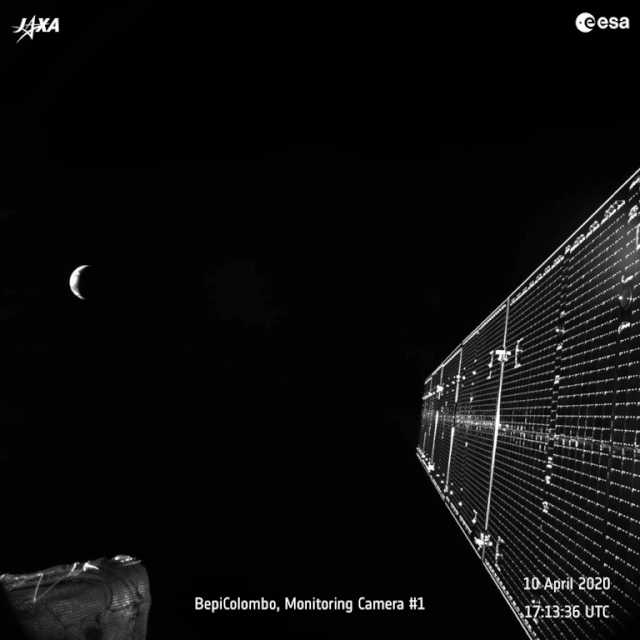This stunning crescent Earth is the last view of home from the Mercury-bound BepiColombo

The BepiColombo spacecraft headed for Mercury showed off an epic last view of Earth while zooming away from our planet on Friday and Saturday (April 10 and 11).
Footage from the spacecraft shows a crescent Earth slipping away from the structure of the European-Japanese probe, which should arrive in orbit Mercury in 2025. The Earth flyby was one of a series of planetary encounters needed to lose speed for the long journey, a procedure that saves on fuel.
The spacecraft zoomed to as low as 7,900 miles (12,700 kilometers) above our planet, with an altitude roughly 32 times the normal cruising orbit of the International Space Station.
Related: BepiColombo in pictures: A Mercury mission by Europe and Japan
"Images gathered just before closest approach portray our planet shining through darkness, during one of humankind's most challenging times in recent history," wrote the European Space Agency in a statement. Officials had previously urged astronomy enthusiasts to observe novel coronavirus-related "social distancing" guidelines while searching for the spacecraft from their balconies or backyards.
One of the most difficult parts of the flyby involved 34 minutes of darkness for BepiColombo, when it flew through the shadow of Earth. This was the first time the solar-powered spacecraft did not receive sunlight to "power up" instruments and essential equipment since its launch 18 months ago, in October 2018.
To prepare for the darkness, mission operators fully charged the spacecraft's batteries and made sure all components were nice and warm. Social distancing efforts due to the ongoing coronavirus pandemic were in force at the spacecraft mission control center in Darmstadt, Germany, with only limited personnel on site. The effort worked without any problems, ESA added in the same statement.
Breaking space news, the latest updates on rocket launches, skywatching events and more!
"It is always nerve-wracking to know a spacecraft's solar panels are not bathed in sunlight. When we saw the solar cells had restarted to generate electrical current, we knew BepiColombo was finally out of Earth's shadow and ready to proceed on its interplanetary journey," Elsa Montagnon, BepiColombo spacecraft operations manager for ESA, said in the statement.
Scientists switched on most of the instruments during the flyby to do scientific measurements of the moon and Earth's magnetic field, ESA added. These observations will serve as a test run for operations at Mercury. BepiColombo scientists will analyze the data in time to make any necessary calibrations for the spacecraft's next flyby, which will be of Venus in October.
ESA marked the maneuver's conclusion by sharing an animation of images captured as the spacecraft flew away from Earth within a day of the flyby, paired with a quote from famous astronomer Carl Sagan. "That receding crescent … 'Look again at that dot. That's here. That's home. That's us. On it everyone you love, everyone you know, everyone you ever heard of, every human being who ever was, lived out their lives.' - Carl Sagan. Farewell @BepiColombo, and goodnight."
That receding crescent... “Look again at that dot. That's here. That's home. That's us. On it everyone you love, everyone you know, everyone you ever heard of, every human being who ever was, lived out their lives." - Carl SaganFarewell @BepiColombo, and goodnight. pic.twitter.com/Q2F7lClu7iApril 11, 2020
Numerous spacecraft and agency Twitter feeds provided updates on the mission during and after the flyby.
"Dear Earthlings, I'm almost one million km from Earth now and I miss you so much," the @BepiColombo Twitter account said Monday (April 13). "It would make me so happy if you could share any photos you've taken of my flyby on Friday." The account added a link to a Flickr group hosting photos of the flyby taken by amateur photographers tracking the spacecraft's passage.
The animation also caught the attention of some prominent tweeters.
"EXCEPTIONAL MUTUAL GLANCE: #BepiColombo was looking us while we were looking at it, AT THE VERY SAME TIME," wrote the hosts of the Virtual Telescope project, based in Italy, on Twitter on Saturday (April 11), sharing a composite of their image and that of the spacecraft.
London's Northolt Branch Observatories, which typically studies comets and asteroids during Earth flybys, posted a picture on Twitter showing its view of BepiColombo in the sky. "It was visible at +16.9 mag at the time, in the direction of the constellation Hydra," the tweet on Sunday (April 12) read. A +6 magnitude in brightness is considered the threshold of naked-eye visibility, so +16.9 magnitude is only visible in a large telescope.
Scientific updates about the mission's progress will be available in the coming weeks at @ESA_Bepi, @ESA_MTM and @BepiColombo.
- Photos of Mercury from NASA's Messenger spacecraft
- What a view! Mercury probe snaps stunning photos of our planet during Earth flyby.
- See amazing photos of Mercury by a doomed NASA spacecraft (video)
Follow Elizabeth Howell on Twitter @howellspace. Follow us on Twitter @Spacedotcom and on Facebook.
OFFER: Save 45% on 'All About Space' 'How it Works' and 'All About History'!
For a limited time, you can take out a digital subscription to any of our best-selling science magazines for just $2.38 per month, or 45% off the standard price for the first three months.

Elizabeth Howell (she/her), Ph.D., was a staff writer in the spaceflight channel between 2022 and 2024 specializing in Canadian space news. She was contributing writer for Space.com for 10 years from 2012 to 2024. Elizabeth's reporting includes multiple exclusives with the White House, leading world coverage about a lost-and-found space tomato on the International Space Station, witnessing five human spaceflight launches on two continents, flying parabolic, working inside a spacesuit, and participating in a simulated Mars mission. Her latest book, "Why Am I Taller?" (ECW Press, 2022) is co-written with astronaut Dave Williams.

